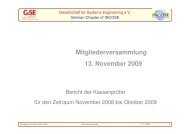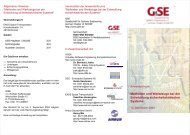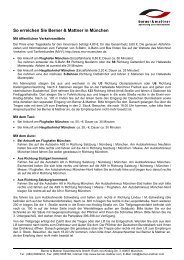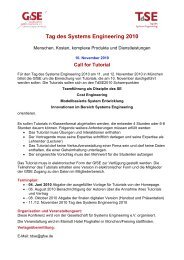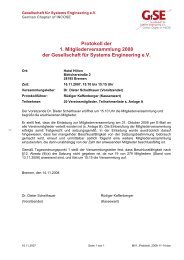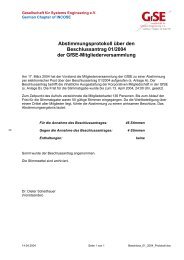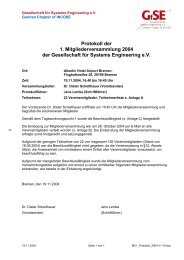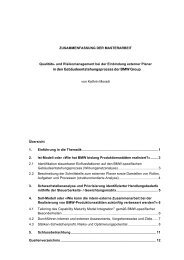Summary of Diploma Thesis_Christian Eger - GfSE
Summary of Diploma Thesis_Christian Eger - GfSE
Summary of Diploma Thesis_Christian Eger - GfSE
You also want an ePaper? Increase the reach of your titles
YUMPU automatically turns print PDFs into web optimized ePapers that Google loves.
Preliminary Model Philosophy<br />
Testing and qualification <strong>of</strong> the system- and subsystem-design requires models. This<br />
includes digital mock-ps (e.g. CAD models), s<strong>of</strong>tware models, simplified engineering models<br />
<strong>of</strong> hardware, or qualification models identical to the final flight hardware. Depending on the<br />
intended approach for the verification <strong>of</strong> the system, a selection <strong>of</strong> models has to be<br />
determined in such way that the qualification <strong>of</strong> the system versus its requirements can be<br />
achieved, but the model costs are kept as low as possible on the other hand.<br />
For ARV, a preliminary selection <strong>of</strong> the basic models for the main the capsule, the service<br />
module and for subsystems, which would involve new technologies, was chosen based on<br />
the results <strong>of</strong> the technology readiness analysis and a review <strong>of</strong> the model philosophies<br />
proposed in previous concept studies. These were then checked against the experiences<br />
made in the qualification process <strong>of</strong> realized space systems, (e.g. Columbus and ATV) and<br />
also adapted to the technical experience <strong>of</strong> potential subcontractors who were considered to<br />
become the developers <strong>of</strong> the respective system parts.<br />
Engineering Management Approaches<br />
This section was dedicated to the question which control instruments are required to assure<br />
that the coming engineering work in the ARV program will be performed efficiently and that<br />
technical risks can be identified and controlled early in the development process. In project<br />
reality this is assured by dedicated control boards. Therefore suitable types <strong>of</strong> control boards<br />
were collocated (e.g. Configuration Control Board, Change Control Boards) and some basic<br />
rules for the formal process how they should work were defined.<br />
Additionally, general areas <strong>of</strong> responsibility <strong>of</strong> were defined and allocated to the different<br />
parties involved in the development process, meaning the prime contractor, subsystem<br />
contractors, part suppliers etc.<br />
Specific System Engineering Tasks and Approaches<br />
The identification <strong>of</strong> special system engineering tasks itself and the presentation <strong>of</strong> suitable<br />
approaches how to perform them makes typically the largest part <strong>of</strong> a D&D plan.<br />
For the preliminary plan this part was mostly reduced to the mere identification <strong>of</strong> the system<br />
engineering tasks and to the review <strong>of</strong> existing D&D plans for approaches that had proved to<br />
be successful and could be adapted to ARV or even taken over unchanged. Also ECSS 2<br />
development standards that could potentially be applied for these approaches were identified<br />
and taken into account. Only some examples for the topics that were addressed are:<br />
2 European Cooperation on Space Standardisation: Joint board <strong>of</strong> Space Agencies and European<br />
space companies that establishes common standards for development activities in space business<br />
6




